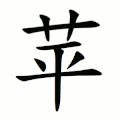Hello, you have come here looking for the meaning of the word
苹 . In DICTIOUS you will not only get to know all the dictionary meanings for the word
苹 , but we will also tell you about its etymology, its characteristics and you will know how to say
苹 in singular and plural. Everything you need to know about the word
苹 you have here. The definition of the word
苹 will help you to be more precise and correct when speaking or writing your texts. Knowing the definition of
苹 , as well as those of other words, enriches your vocabulary and provides you with more and better linguistic resources.
Translingual
Stroke order
Han character 苹 Kangxi radical 140, 艸 +5, 8 strokes, cangjie input 廿一火十 (TMFJ ), four-corner 44409 , composition ⿱艹 平 )
Derived characters
References Kangxi Dictionary: page 1025 , character 10
Dai Kanwa Jiten: character 30823
Dae Jaweon: page 1484, character 16
Hanyu Da Zidian (first edition): volume 5, page 3189, character 4
Unihan data for U+82F9
Chinese
Glyph origin
Old Chinese
平 *ben, *beŋ
怦 *pʰreːŋ
砰 *pʰreːŋ
抨 *pʰreːŋ
閛 *pʰreːŋ
伻 *pʰreːŋ
評 *beŋ, *beŋs
坪 *beŋ
苹 *beŋ
枰 *beŋ, *beŋs
泙 *beŋ
蚲 *beŋ
胓 *beŋ
匉 *pʰreːŋ
萍 *beːŋ
Phono-semantic compound (形聲 / 形声 OC *beŋ ): semantic 艸 平 ( OC *ben, *beŋ ) .
Etymology 1 For pronunciation and definitions of 苹 – see 蘋 apple ; Chinese chestnut ”). This character is the simplified form of 蘋 Notes:
Usage notes This simplified glyph is used in 苹果 ( píngguǒ ) .
Etymology 2
Pronunciation
Baxter –Sagart system 1.1 (2014 )
Character
苹
Reading #
1/1
Modern
píng
Middle
‹ beng ›
Old
/*ˁeŋ/
English
duckweed
Notes for Old Chinese notations in the Baxter–Sagart system:
* Parentheses "()" indicate uncertain presence;
* Period "." indicates syllable boundary.
Zhengzhang system (2003)
Character
苹
Reading #
1/1
No.
9821
Phonetic
平
Rime
耕
Rime
0
Corresponding
平
Old
/*beŋ/
Definitions 苹
alternative form of 萍 ( “ duckweed ” )
呦呦 鹿 鳴 ,食 野 之 苹 。呦呦 鹿 鸣 ,食 野 之 苹 。From: The Classic of Poetry c. th – 7th centuries BCE James Legge 's versionYōuyōu lù míng, shí yě zhī píng . With pleased sounds the deer call to one another, eating the celery of the fields. Alternative name for 藾蕭 / 𰱾萧 Artemisia argyi
Compounds
References
Japanese
Kanji 苹
(Hyōgai kanji )
This term needs a translation to English. Please help out and add a translation , then remove the text {{rfdef }}.
Readings
Compounds
Korean
Hanja 苹 • (pyeong )hangeul 평 revised pyeong, McCune–Reischauer p'yŏng, Yale phyeng)
This term needs a translation to English. Please help out and add a translation , then remove the text {{rfdef }}.
